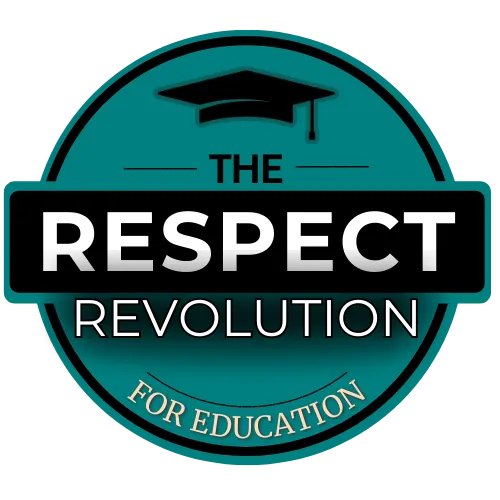
RESOURCE ARTICLE
The Secret to Classroom Management: Making Discipline Fun in High School
Brad Reed | Director | The Respect Revolution | 25 November 2024
What do soccer have to do with your high school class? Can discipline actually be fun for both teachers and students? And can we finally end that exhausting “teacher-versus-student” dynamic in our classrooms once and for all?
Today, we’re diving into how something as simple as soccer referee cards can completely transform classroom management. Forget the typical shout-outs or stressful confrontations; let’s talk about discipline that works for everyone and keeps the classroom vibe positive.
Why Traditional Discipline Methods Fall Short
Traditional discipline in classrooms tends to follow one of two extremes. On one end, you’ve got methods that feel too harsh, making teachers feel more like drill sergeants than educators. On the other, some methods are too lenient, allowing students to overstep boundaries and leaving teachers feeling out of control. Either way, traditional discipline almost always becomes a battle of “teacher versus student.” This dynamic sets up constant confrontation and hard feelings, ultimately disrupting the learning environment.
Neither approach builds the mutual respect we all want in our classrooms. In fact, they often have the opposite effect—undermining trust and creating barriers. So, what if discipline could be handled like a game, where everyone understands the rules, the stakes are clear, and—best of all—it’s actually kind of fun?
How Soccer Referee Cards Work in the Classroom
In soccer, referees use a straightforward system: a yellow card is a warning, and a red card results in ejection from the game. The beauty of this approach is its simplicity, non-verbal cues, and clarity. Players understand that arguing over a card doesn’t change the outcome; it only makes things worse.
In the classroom, the soccer card system works similarly. Students know they’re not being punished personally, just that they’ve broken the established rules of the “game.” They usually accept it with minimal pushback because the consequences are clear, fair, and non-negotiable—much like on the soccer field. It also takes very little time or distraction to use. Just a quick flash of a card communicates everything, and the class can move on without much interruption.
Implementing the Soccer Card System in Your Classroom
If you’re interested in trying this, here’s how to get started:
Get a Red and Yellow Card
You could use colored construction paper, but investing in real referee cards adds a bit of fun and shows students you’re serious about this new system. You can pick up a set for just a few dollars online or at a sports store.
Set Clear Ground Rules
Outline what behaviors will earn a yellow or red card, just as there are clear rules in soccer. Maybe talking out of turn or being disruptive is a yellow card, while a more severe infraction, like blatant disrespect, is a straight red. Make sure your rules are clear and consistent, as that’s what makes this system effective.
Introduce the System to Students
Many students are already familiar with the concept of yellow and red cards, but if not, explain it to them in a lighthearted way. You can even show a short video clip from a soccer match to illustrate the concept. Be sure to let them know when this system will start and answer any questions they might have.
Monitor & Adjust as Needed
Keep an eye on how students respond to the system. You may need to make small adjustments, like being a bit more patient with certain students or adjusting your criteria for issuing cards. Listen for students referencing the system themselves; it’s a good sign they’re taking it seriously.
Why This System Works So Well
One of the key benefits of using soccer cards is that it turns discipline into a predictable game rather than a personal confrontation. Students are less likely to argue because the system is simple and non-negotiable, much like on the soccer field. This also helps them see you not as a disciplinarian but as someone enforcing the rules of a game.
With soccer cards, discipline becomes less about control and more about clarity. Students start to understand that there’s no power struggle, just the natural consequences of breaking rules. They may even smile or nod when they receive a card because they know it’s part of the “game.” By keeping the interactions light and non-confrontational, you foster a classroom culture built on respect and understanding.
Adapting the System to Fit Your Style
If soccer isn’t the right fit for your students, consider using other game systems they’re familiar with. One teacher I know uses “hit points” like in a role-playing game, where students “lose points” for poor behavior. Another uses yellow flags, like in football, and throws them for unsportsmanlike conduct. The key is to find a structure that resonates with your students and keeps discipline lighthearted yet effective.
Does This Really Work?
In my experience—and in the experiences of many teachers I’ve worked with—this approach has been incredibly effective. Students are more motivated to follow the rules, and when discipline issues arise, they’re dealt with swiftly and fairly. Teachers using this system report feeling more in control without feeling adversarial, and classrooms become more positive and engaging for everyone involved.
Final Thoughts: Building a Respect Revolution
This method is just one piece of a broader philosophy we call the “Respect Revolution.” It’s about creating respectful partnerships with students rather than enforcing discipline through power and control. If you’re interested in learning more, we’ve got a free guide, Building Positive Relationships with High School Students, available for download on our website. It’s packed with actionable steps to help you create a respectful, connected, and energized classroom environment.
Ready to turn discipline into a game? Let’s work together to create a classroom culture that’s engaging, respectful, and just plain fun!
Check out this article as a video on our YouTube channel:

PRIVACY POLICY | TERMS & CONDITIONS | CONTACT US
© COPYRIGHT 2024. THE RESPECT REVOLUTION. ALL RIGHTS RESERVED
Stay connected and join the movement!





